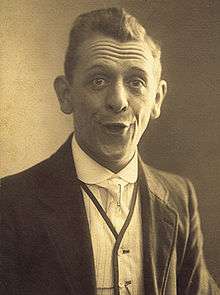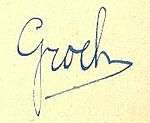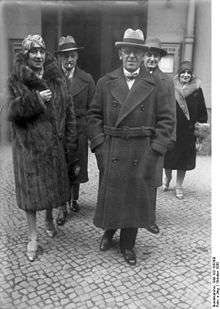Grock
| Grock | |
|---|---|
 Grock in 1903 | |
| Born |
Charles Adrien Wettach January 10, 1880 Loveresse, Canton of Bern |
| Died |
July 14, 1959 (aged 79) Imperia, Italy |
| Occupation | Clown, music hall performer |
| Years active | 1890s–1954 |
Grock (January 10, 1880 – July 14, 1959), born Charles Adrien Wettach,[1] was a Swiss clown, composer and musician. Called "the king of clowns"[2] and "the greatest of Europe's clowns",[3] Grock was once the most highly paid entertainer in the world.[2]
Biography
Early life
Grock was born in Loveresse, a village in the Bernese Jura in the Canton of Bern. He started early as a performer, learning musicianship and acrobatic skills from his father.[4] When a caravan of Roma passed through, he joined them, learning more instruments and gaining confidence with them. In 1894, he debuted with Fiame Wetzel's traveling circus.[4] He became a clown, working first with Brick in 1903, adopting the name "Grock", and then the famous clown Antonet (Umberto Guillaum).[5] This second act was developed with the aim of making the transition from circus to music hall stages, which were more lucrative. While not initially successful, Antonet and Grock did manage to secure a London engagement in 1911. Refining their performances according to audience response, Grock came to dominate the act, and they eventually split up.
Career and later life



By 1913, Grock's fame had spread, his act having developed into the mixture of pantomime and musical blunders for which he is now remembered.[5] With the outbreak of World War I, he made Britain his base, remaining there until 1924, when he returned to continental Europe. He performed throughout Europe and in the United States, commanding ever higher fees, and his continuing success enabled him to establish his own circus in 1951, with which he toured until his final performance in Hamburg on October 30, 1954.[6] Grock described the secret of clowning as follows: "The genius of clowning is transforming the little, everyday annoyances, not only overcoming, but actually transforming them into something strange and terrific… it is the power to extract mirth for millions out of nothing and less than nothing."[7]
He retired to the Villa Bianca (now named "Villa Grock"), a 50-room house he had had built in the 1920s in Imperia, Italy, where he died in 1959.
Media
Some of Grock's performances have been preserved on film. He made the 1927 silent movie What For?, and French and German language versions of Grock in 1931. A biopic, Au revoir, M. Grock (1950), featured Grock as himself,[8] with Adrien Osperi and Ted Rémy playing Grock as a boy and young man, respectively.
In retirement, he made some appearances on Italian television. He also authored several books, including an autobiography.
Legacy
Grock's career is commemorated with the Grock d'Or, an annual competition for young circus artists which first took place in 2003.[9] This competition has been discontinued since 2008.
Filmography
- Clear the Ring (1950)
Books
- "Grock. Nit mö-ö-ö-glich. Die Memoiren des Königs der Clowns", autobiography (1956) (German); English version: "Grock, King of Clowns" (1957)
Notes
- ↑ Some sources give this as "Karl Adrian Wettach".
- 1 2 Pat Cashin, Grock Clown Alley (blog). (August 24, 2006). Retrieved April 22, 2011
- ↑ "Life on the Newsfronts of the World" Google Books. Life magazine (November 15, 1954). Retrieved April 22, 2011.
- 1 2 Frank Cullen, Florence Hackman and Donald McNeilly Vaudeville, Old & New Google Books. Routledge (2007) pp. 462–463. Retrieved April 22, 2011
- 1 2 "Grock". Britannica Online Encyclopedia. Encyclopædia Britannica. Retrieved 2008-12-20.
- ↑ Wettach, Adrien (1957). Grock, King of Clowns. Methuen. p. 219.
- ↑ "Karl Adrien "Grock" Wettach (Jan. 10, 1880 - July 14, 1959)". Famous Clowns.
- ↑ Bullock, Alan (1980). The Faces of Europe. Phaidon Press. p. 103.
- ↑ "Le 5e Grock d'Or part pour Genève". Association Grockland.
Additional references
- Law, M. D., ed. (1950). "Grock". Chambers's Encyclopaedia. George Newnes. p. 600.
- "Grock". www.steffi-line.de (in German). Retrieved 2008-12-20.
External links
- Video of Grock stage performance on YouTube (French)
- Grock-News (German)
- Association Grockland (French)
- Grock at the Internet Movie Database
- "Grock - Seltsamer als die Wahrheit" FilmArts Productions, Zurich (2006) (German)
- Museo del Clown
- Grock inducted into the Clown Hall of Fame